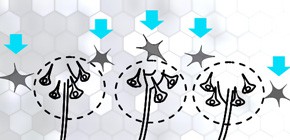
Microglial cells accelerate maturation of cortical synapses in early postnatal stages
Under the leadership of HOSHIKO Maki , Graduate School of Frontier Biosciences, Osaka University (currently, Yuzaki Laboratory, School of Medicine, Keio University), and YAMAMOTO Nobuhiko , Graduate School of Frontier Biosciences, Osaka University, and Etienne Audinat , Professor, University of Paris, France, a group of researchers have clarified that not only are microglial cells crucial in maintenance of the brain environment, but also play a functional role in CNS development.
Signals from mouse whiskers are eventually transmitted to the somatosensory cortex. When the neural circuits are formed, microglial cells piled up by an inducible molecule, chemokine, at sites where incoming fibers and cerebral neurons are bound, promote neurotransmission. In other words, at the postnatal development stage, microglial cells induced by chemokine from nerve cells, develop functions of neuronetwork and accelerate its functional maturation.
Abstract
Accumulative evidence indicates that microglial cells influence the normal development of brain synapses. Yet, the mechanisms by which these immune cells target maturating synapses and influence their functional development at early postnatal stages remain poorly understood. Here, we analyzed the role of CX3CR1, a microglial receptor activated by the neuronal chemokine CX3CL1 (or fractalkine) which controls key functions of microglial cells. In the whisker-related barrel field of the mouse somatosensory cortex, we show that the recruitment of microglia to the sites where developing thalamocortical synapses are concentrated (i.e., the barrel centers) occurs only after postnatal day 5 and is controlled by the fractalkine/CX3CR1 signaling pathway. Indeed, at this developmental stage fractalkine is overexpressed within the barrels and CX3CR1 deficiency delays microglial cell recruitment into the barrel centers. Functional analysis of thalamocortical synapses shows that CX3CR1 deficiency also delays the functional maturation of postsynaptic glutamate receptors which normally occurs at these synapses between the first and second postnatal week. These results show that reciprocal interactions between neurons and microglial cells control the functional maturation of cortical synapses.

Figure
To learn more about this research, please read the full research report entitled " Deficiency of the Microglial Receptor CX3CR1 Impairs Postnatal Functional Development of Thalamocortical Synapses in the Barrel Cortex " at this page of the Journal of Neuroscience website.
Related link

